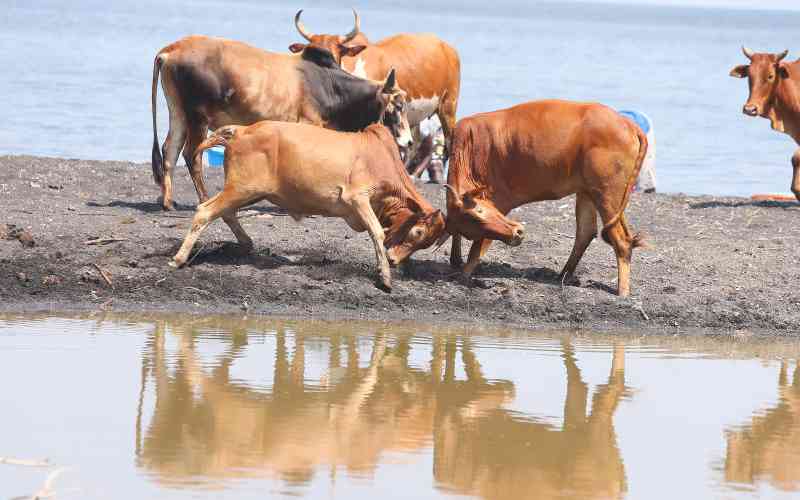Nearly three-quarters of the rural poor and some one-third of the urban poor depend on livestock for their food, income, traction, manure or other services.
Livestock provide poor households with up to half their income and between six and 35 per cent of their protein needs. With that in mind, the loss of a single milking animal can be devastating to such households. But the more devastating eventuality is the loss of a relative to a zoonotic disease. A zoonotic disease is an infection transmitted from an animal to humans.
Such transmissions happen because some households are so attached to their animals to an extent of keeping them in their houses at night in fear of theft. One of the zoonotic diseases that can be transmitted when humans come in frequent close contact with livestock is tuberculosis.
In humans, the vast majority of cases of TB are caused by Mycobacterium tuberculosis. However, TB can be caused by a number of other bacteria, including Mycobacterium bovis, which causes bovine tuberculosis (TB in cattle which can be transmitted to humans).
TB due to M bovis often occupies sites other than the lungs (it is extra-pulmonary), but in many cases is clinically indistinguishable from Mycobacterium tuberculosis infection. However, patients with Mycobacterium bovis often do not respond to drugs commonly used to treat TB, sometimes resulting in a fatal outcome. Other, far more expensive drugs are often needed – placing an added burden on households.
Though Bovine TB is prevalent in Kenya, effective disease surveillance and control, including regular milk pasteurisation and slaughterhouse meat inspection is largely absent in rural areas. This situation is exacerbated by the presence of multiple additional risk factors such as human behaviour and high prevalence of HIV infections.
In spite of newer modalities for diagnosis and treatment of TB, people are still suffering.
According to World Health Organisation, TB is a worldwide pandemic. It is a leading cause of death among HIV-infected people.
One of the ways to stem the problem is the diagnosis of bovine TB in animals.
The disease can be picked by a Tuberculin test. It is injected by a vet into the skin on the side of the animal’s neck and the reaction is read after 72 hours. The presence of any swelling means the animal is infected. This test in infected cattle is highly sensitive. It is important to note that sensitivity develops within four weeks of infection and so recently infected animals may therefore pass the test. Occasionally, it is also detected during meat inspections.
But you can also suspect TB in cattle that:
• keep getting thinner
• have a light fever that keeps coming back
• are weak and have a reduced appetite
• have swollen lymph nodes, for example in the neck
Stay informed. Subscribe to our newsletter
• have a moist cough that gets worse in the morning and during cold weather or exercise
• have chronic mastitis (an infection of the udder that is not cured by the conventional antibiotic therapy)
Risk to humans
Humans can catch bovine TB through:
• unpasteurised milk or dairy products from an infected animal
• inhaling bacteria breathed out by infected animals
• inhaling bacteria released from the carcasses of infected animals or from their excretions (such as faeces)
How to reduce and avoid the risk of infection:
• isolate suspect animals and their carcasses
• do not get too close to the heads of infected animals or hold them
• avoid unpasteurised milk from suspect animals
• wash your hands regularly, especially before eating
• don’t eat or drink in animal habitats
How bovine TB is spread
Bovine TB is mainly spread into new herds through the movement of infected cattle that have not been detected. Infected animals spread the disease mainly through coughing and sneezing. Bacteria are released into the air and inhaled by other animals in close contact.
Prevention
• Keep cattle premises clean and hygienic at all times. Clean feed troughs, water troughs and disinfect cattle premises.
• Milk fed to calves should be sterilised.
• Sick animals should be isolated.
• Sick people should not handle animals. People infected with tuberculosis caused by M bovis can transmit infection to cattle.
• The stress of repeated pregnancies and lactations weakens host defences, allowing the disease to develop progressively, until it becomes clinically significant. Thus, tuberculosis is seen most often in housed dairy cattle, especially older animals and where hygiene is poor
• Mycobacteria may survive on shaded pasture for weeks or months and in yards or houses. Direct sunshine rapidly kills the organisms.
• Never sell or buy sick animals
Treatment and control
Treatment and vaccination play no part in the control of tuberculosis in animals.
Ideally, control of bovine tuberculosis is test and slaughter or test and segregate.
The writer runs One health resource centre which disseminates info on zoonotic diseases
[email protected]
 The Standard Group Plc is a
multi-media organization with investments in media platforms spanning newspaper
print operations, television, radio broadcasting, digital and online services. The
Standard Group is recognized as a leading multi-media house in Kenya with a key
influence in matters of national and international interest.
The Standard Group Plc is a
multi-media organization with investments in media platforms spanning newspaper
print operations, television, radio broadcasting, digital and online services. The
Standard Group is recognized as a leading multi-media house in Kenya with a key
influence in matters of national and international interest.
 The Standard Group Plc is a
multi-media organization with investments in media platforms spanning newspaper
print operations, television, radio broadcasting, digital and online services. The
Standard Group is recognized as a leading multi-media house in Kenya with a key
influence in matters of national and international interest.
The Standard Group Plc is a
multi-media organization with investments in media platforms spanning newspaper
print operations, television, radio broadcasting, digital and online services. The
Standard Group is recognized as a leading multi-media house in Kenya with a key
influence in matters of national and international interest.









